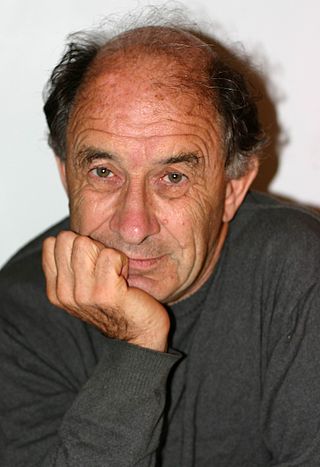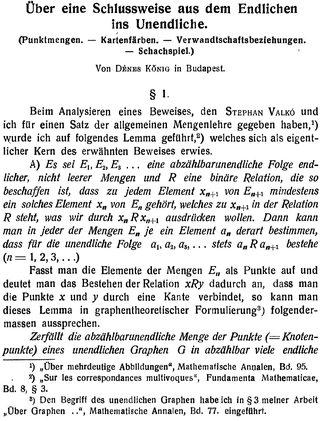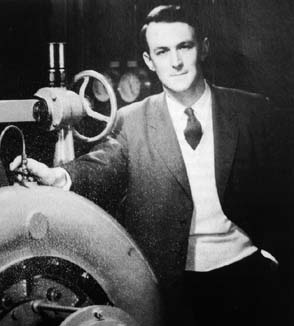
In mathematics, the axiom of choice, or AC, is an axiom of set theory equivalent to the statement that a Cartesian product of a collection of non-empty sets is non-empty. Informally put, the axiom of choice says that given any collection of sets, each containing at least one element, it is possible to construct a new set by arbitrarily choosing one element from each set, even if the collection is infinite. Formally, it states that for every indexed family of nonempty sets, there exists an indexed set such that for every . The axiom of choice was formulated in 1904 by Ernst Zermelo in order to formalize his proof of the well-ordering theorem.
In mathematics, the Hausdorff maximal principle is an alternate and earlier formulation of Zorn's lemma proved by Felix Hausdorff in 1914. It states that in any partially ordered set, every totally ordered subset is contained in a maximal totally ordered subset.

Max August Zorn was a German mathematician. He was an algebraist, group theorist, and numerical analyst. He is best known for Zorn's lemma, a method used in set theory that is applicable to a wide range of mathematical constructs such as vector spaces, and ordered sets amongst others. Zorn's lemma was first postulated by Kazimierz Kuratowski in 1922, and then independently by Zorn in 1935.

In mathematics, a theorem is a statement that has been proved, or can be proved. The proof of a theorem is a logical argument that uses the inference rules of a deductive system to establish that the theorem is a logical consequence of the axioms and previously proved theorems.

Vladimir Igorevich Arnold was a Soviet and Russian mathematician. While he is best known for the Kolmogorov–Arnold–Moser theorem regarding the stability of integrable systems, he made revolutionary and deep contributions in several areas including geometrical theory of dynamical systems theory, algebra, catastrophe theory, topology, algebraic geometry, symplectic geometry, symplectic topology, differential equations, classical mechanics, differential geometric approach to hydrodynamics, geometric analysis and singularity theory, including posing the ADE classification problem, since his first main result—the solution of Hilbert's thirteenth problem in 1957 at the age of 19. He co-founded two new branches of mathematics—KAM theory, and topological Galois theory. He is widely regarded as one of greatest mathematicians of all time.
In mathematics, the well-ordering theorem, also known as Zermelo's theorem, states that every set can be well-ordered. A set X is well-ordered by a strict total order if every non-empty subset of X has a least element under the ordering. The well-ordering theorem together with Zorn's lemma are the most important mathematical statements that are equivalent to the axiom of choice. Ernst Zermelo introduced the axiom of choice as an "unobjectionable logical principle" to prove the well-ordering theorem. One can conclude from the well-ordering theorem that every set is susceptible to transfinite induction, which is considered by mathematicians to be a powerful technique. One famous consequence of the theorem is the Banach–Tarski paradox.

Zorn's lemma, also known as the Kuratowski–Zorn lemma, is a proposition of set theory. It states that a partially ordered set containing upper bounds for every chain necessarily contains at least one maximal element.

Kőnig's lemma or Kőnig's infinity lemma is a theorem in graph theory due to the Hungarian mathematician Dénes Kőnig who published it in 1927. It gives a sufficient condition for an infinite graph to have an infinitely long path. The computability aspects of this theorem have been thoroughly investigated by researchers in mathematical logic, especially in computability theory. This theorem also has important roles in constructive mathematics and proof theory.
An in-joke, also known as an inside joke or a private joke, is a joke whose humour is understandable only to members of an ingroup; that is, people who are in a particular social group, occupation, or other community of shared interest. It is, therefore, an esoteric joke, only humorous to those who are aware of the circumstances behind it.
In mathematics, the Boolean prime ideal theorem states that ideals in a Boolean algebra can be extended to prime ideals. A variation of this statement for filters on sets is known as the ultrafilter lemma. Other theorems are obtained by considering different mathematical structures with appropriate notions of ideals, for example, rings and prime ideals, or distributive lattices and maximal ideals. This article focuses on prime ideal theorems from order theory.
Reverse mathematics is a program in mathematical logic that seeks to determine which axioms are required to prove theorems of mathematics. Its defining method can briefly be described as "going backwards from the theorems to the axioms", in contrast to the ordinary mathematical practice of deriving theorems from axioms. It can be conceptualized as sculpting out necessary conditions from sufficient ones.
In mathematics, the axiom of dependent choice, denoted by , is a weak form of the axiom of choice that is still sufficient to develop most of real analysis. It was introduced by Paul Bernays in a 1942 article that explores which set-theoretic axioms are needed to develop analysis.

The Benjamin–Bona–Mahony equation is the partial differential equation

Thomas Brooke Benjamin, FRS was an English mathematical physicist and mathematician, best known for his work in mathematical analysis and fluid mechanics, especially in applications of nonlinear differential equations.
In mathematics, the Teichmüller–Tukey lemma, named after John Tukey and Oswald Teichmüller, is a lemma that states that every nonempty collection of finite character has a maximal element with respect to inclusion. Over Zermelo–Fraenkel set theory, the Teichmüller–Tukey lemma is equivalent to the axiom of choice, and therefore to the well-ordering theorem, Zorn's lemma, and the Hausdorff maximal principle.
Henry Christian Wente was an American mathematician, known for his 1986 discovery of the Wente torus, an immersed constant-mean-curvature surface whose existence disproved a conjecture of Heinz Hopf.
Alexander A. Kiselev is an American mathematician, specializing in spectral theory, partial differential equations, and fluid mechanics.
Equivalents of the Axiom of Choice is a book in mathematics, collecting statements in mathematics that are true if and only if the axiom of choice holds. It was written by Herman Rubin and Jean E. Rubin, and published in 1963 by North-Holland as volume 34 of their Studies in Logic and the Foundations of Mathematics series. An updated edition, Equivalents of the Axiom of Choice, II, was published as volume 116 of the same series in 1985.








